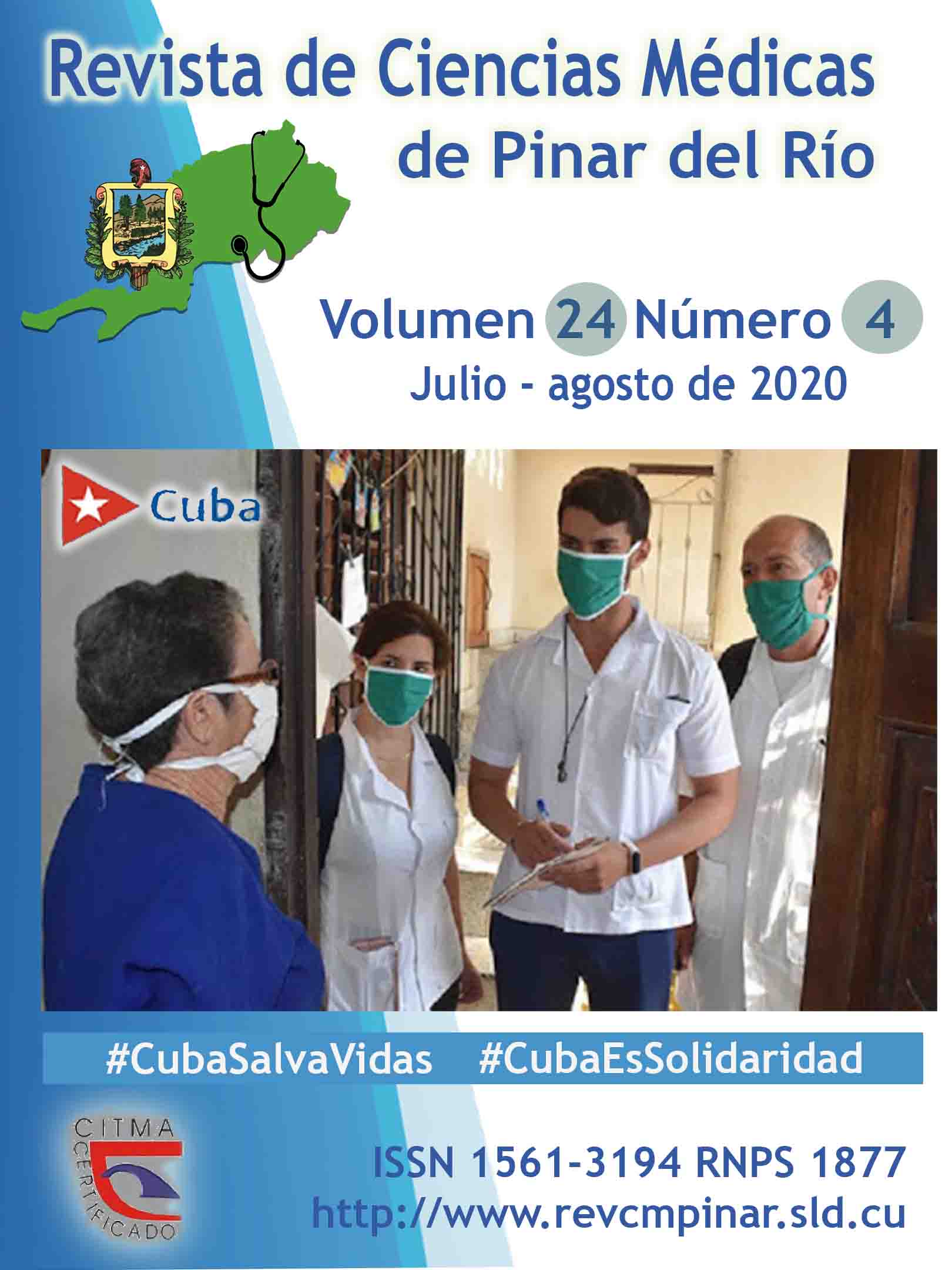Multidimensional analgesia for terminal stage patients with pancreatic cancer
Keywords:
CANCER, MULTIDIMENSIONAL ANALGESIA, FINAL STAGE, PANCREAS TUMOR.Abstract
Introduction: cancer is the second leading cause of death in the world; the tumors of the digestive system occupy the second place and according to itslocation, those in the pancreas have the lowest survival rate.
Objective: to assess the effectiveness of multidimensional analgesia for patients in terminal stage due to pancreatic cancer.
Methods: a quasi-experimental, comparative, prospective and longitudinal study was conducted in patients with pain due to pancreatic tumor in terminal stage at Abel Santamaria Cuadrado General Teaching Hospital from November 2016 to July 2019; all patients with pain due topancreatictumor were included. In the terminal stage of pancreatic cancer, three (3) groups were completed according to the analgesia method applied; Group I (n = 10) multimodal analgesia, Group II (n = 10) multidimensional analgesia and Group III (n = 3) following WHO analgesia scheme, analgesia quality, and the need for rescue dose and application of morphine, the methods were compared and survival rate was determined.
Results: the quality of analgesia was higher in patients from group II, in the same group the application of morphine was not required until the 7th month and in only two patients (p = 0.00), there were no differences in the rates of survival.
Conclusions: the multidimensional approach to analgesia, where the individual is included as a biopsychosocial being and the family achieves greater quality of analgesia, the method applied for pain relief does not influence on survival.
Downloads
References
1. OMS. Datos Y Cifras Sobre El Cáncer [Internet]. OMS; 2020 [citado 17/05/2020]. Disponible en: https://www.who.int/cancer/about/facts/es
2. Ministerio de Salud Pública, Dirección de Registros Médicos y Estadísticas. Anuario Estadístico de Salud 2017 [Internet]. La Habana; 2018. [citado 17/05/2020]: [aprox. 191p.]. Disponible en: https://files.sld.cu/dne/files/2018/04/Anuario-Electronico-Espa%c3%b1ol-2017-ed-2018.pdf
3. National Cancer Institute. Cancer pain (PDQ) Health professional version [Internet]. 2017 [Actualizado 30/08/2017; citado 17/05/2020] www.cancer.gov/about-cancer/treatment/side-effects/pain/pain-hp-pdq
4. De los Reyes-Pacheco VA. Manejo intervencionista del dolor en el paciente oncologico. Revista Mexicana de Anestesiología [Internet]. 2019 [citado 17/05/2020]; 42(supl 1): [aprox. 2p.]. Disponible en: https://www.medigraphic.com/pdfs/rma/cma-2019/cmas191z.pdf
5. Granados GM, Arrieta Rodríguez OG, Hinojosa Gómez J. Tratamiento del cáncer. Oncología Médica, Quirúrgica y Radioterapia [Internet]. 1ed. Axon; 2016 [citado 17/05/2020]. Disponible en: https://axon.es/ficha/libros/9786074485486/tratamiento-del-cancer-oncologia-medica-quirurgica-y-radioterapia
6. Fallon M, Giusti R, Aielli F, et al. Management of cancer pain in adult patients: ESMO Clinical Practice Guidelines. Ann Oncol [Internet]. 2018 [citado 17/05/2020]; 29(Suppl 4): [aprox. 20p.]. Disponible en: https://pubmed.ncbi.nlm.nih.gov/30052758/
7. Laborí Quesada P, Quesada Marrero MD, Aramís Puig Rodríguez O. La familia en los cuidados paliativos del enfermo con cáncer avanzado. Rev Elect Zoilo Marinello [Internet]. 2015 [citado 01/11/2019]; 40(1): [aprox. 9p.]. Disponible en: http://revzoilomarinello.sld.cu/index.php/zmv/article/view/117/201
8. Guerrero Alcedo JM, Ramsés Prepo Serrano A, Gregorio Loyo Álvarez J. Autotrascendencia, ansiedad y depresión en pacientes con cáncer en tratamiento. Barquisimeto. Rev Habanera de Ciencias Médicas [Internet]. 2015 Jun [citado 01/11/2019]; 15(2). [aprox. 11p.]. Disponible en: http://scielo.sld.cu/scielo.php?script=sci_arttext&pid=S0864-215X2006000100011&lng=es
9. Schumacher KL, Stewart BJ, Archbold PG, et al. Effects of caregiving demand, mutuality, and preparedness on family caregiver outcomes during cancer treatment. Oncol Nurs Forum [Internet]. 2008 [citado 03/05/2020]; 35(1): [aprox. 7p.]. Disponible en: https://pubmed.ncbi.nlm.nih.gov/18192152/
10. National Cancer Institute. El cáncer, tratamientos secundarios y efectos; El dolor y el cáncer. Versión para profesionales de salud [Internet]. 2018 [citado 23/10/2019]. Disponible en: https://www.cancer.gov/espanol/
11. Caraceni A, Cherny N, Fainsinger R, et al. Pain measurement tools and methods in clinical research in palliative care: recommendations of an expert working group of the European Association of Palliative Care. J Pain Symptom Manage [Internet]. 2002 [citado 05/03/2020]; 23(3): [aprox. 6p.]. Disponible en: https://pubmed.ncbi.nlm.nih.gov/11888722/
12. Bandieri E, Romero M, Ripamonti C, et al. Randomized trial of lowdose morphine versus weak opioids in moderate cancer pain. J Clin Oncol [Internet] 2016 [citado 05/05/2020]; 34(5): [aprox. 6p.]. Disponible en: https://www.researchgate.net/publication/286376490_Randomized_Trial_of_Low-Dose_Morphine_Versus_Weak_Opioids_in_Moderate_Cancer_Pain
13. DeVita, Hellman, and Rosenberg’s. Cancer Principles & Practice of Oncology [Internet]. 11th ed. Philadelphia: Wolters Kluwer Health; 2019. p. 1459 – 1498. Disponible en: https://lccn.loc.gov/2018043829
14. Asociación del cáncer de páncreas. Pronóstico y supervivencia [Internet]. 2016 Jun [citado 02/10/2019]: [aprox. 6p.]. Disponible en: https://www.asociacioncancerdepancreas.org/informaci%C3%B3n-c%C3%A1ncer/c%C3%A1ncer-de-p%C3%A1ncreas/pron%C3%B3stico-y-supervivencia/
Downloads
Published
How to Cite
Issue
Section
License
Authors who have publications with this journal agree to the following terms: Authors will retain their copyrights and grant the journal the right of first publication of their work, which will be publication of their work, which will be simultaneously subject to the Creative Commons Attribution License (CC-BY-NC 4.0) that allows third parties to share the work as long as its author and first publication in this journal are indicated.
Authors may adopt other non-exclusive license agreements for distribution of the published version of the work (e.g.: deposit it in an institutional telematic archive or publish it in a volume). Likewise, and according to the recommendations of the Medical Sciences Editorial (ECIMED), authors must declare in each article their contribution according to the CRediT taxonomy (contributor roles). This taxonomy includes 14 roles, which can be used to represent the tasks typically performed by contributors in scientific academic production. It should be consulted in monograph) whenever initial publication in this journal is indicated. Authors are allowed and encouraged to disseminate their work through the Internet (e.g., in institutional telematic archives or on their web page) before and during the submission process, which may produce interesting exchanges and increase citations of the published work. (See The effect of open access). https://casrai.org/credit/



